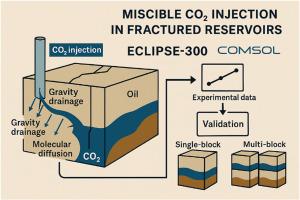天然裂缝性储层注混相气重力排水与分子扩散机制建模
IF 4.1
3区 地球科学
Q2 GEOSCIENCES, MULTIDISCIPLINARY
引用次数: 0
摘要
天然裂缝性储层注气有助于维持储层压力,提高采收率。虽然重力泄放已经得到了广泛的研究,特别是在非混相气体注入场景中,但重力泄放和分子扩散在混相气体注入CO2过程中的联合效应还没有得到广泛的研究。缺乏对这些耦合机制的全面理解代表了一个重大的研究空白,这对于优化这些复杂油藏的提高采收率(EOR)策略至关重要。本研究旨在通过使用Eclipse-300和COMSOL实现混合模拟和建模方法来精确捕获混相CO2注入过程中的流体流动和传质现象,从而解决这一空白。我们利用单区块和多区块模型来研究重力排水和分子扩散的机制。仿真结果与已有的实验数据进行了验证,结果吻合较好。我们的研究结果表明,分子扩散在采收率中起着重要作用,特别是对于小高度和极低渗透率的基质块。例如,有代表性的模拟显示,15小时后总甲烷采收率为35.99%。结果也强调了使用适当的油气饱和度函数进行准确采收率预测的重要性。本文章由计算机程序翻译,如有差异,请以英文原文为准。

Modeling of gravity drainage and molecular diffusion mechanisms during miscible gas injection in naturally fractured reservoirs
Gas injection in naturally fractured reservoirs helps maintain reservoir pressure and improve oil recovery. While gravity drainage has been extensively researched, particularly in immiscible gas injection scenarios, the combined effects of gravity drainage and molecular diffusion during miscible gas injection with CO2 have not been as widely studied. This lack of a comprehensive understanding of these coupled mechanisms represents a significant research gap, which is critical for optimizing Enhanced Oil Recovery (EOR) strategies in these complex reservoirs. This study aims to address this gap by implementing a hybrid simulation and modeling approach using Eclipse-300 and COMSOL to accurately capture fluid flow and mass transfer phenomena during miscible CO2 injection. We utilize single-block and multi-block models to investigate the mechanisms of gravity drainage and molecular diffusion. The simulation results, which were validated against available experimental data, show good agreement. Our findings highlight that molecular diffusion plays a significant role in oil recovery, especially for matrix blocks with small heights and very low permeability. For instance, a representative simulation showed a total methane recovery of 35.99 % after 15 h. The results also underscore the importance of using appropriate oil-gas saturation functions for accurate recovery predictions.
求助全文
通过发布文献求助,成功后即可免费获取论文全文。
去求助
来源期刊

Physics and Chemistry of the Earth
地学-地球科学综合
CiteScore
5.40
自引率
2.70%
发文量
176
审稿时长
31.6 weeks
期刊介绍:
Physics and Chemistry of the Earth is an international interdisciplinary journal for the rapid publication of collections of refereed communications in separate thematic issues, either stemming from scientific meetings, or, especially compiled for the occasion. There is no restriction on the length of articles published in the journal. Physics and Chemistry of the Earth incorporates the separate Parts A, B and C which existed until the end of 2001.
Please note: the Editors are unable to consider submissions that are not invited or linked to a thematic issue. Please do not submit unsolicited papers.
The journal covers the following subject areas:
-Solid Earth and Geodesy:
(geology, geochemistry, tectonophysics, seismology, volcanology, palaeomagnetism and rock magnetism, electromagnetism and potential fields, marine and environmental geosciences as well as geodesy).
-Hydrology, Oceans and Atmosphere:
(hydrology and water resources research, engineering and management, oceanography and oceanic chemistry, shelf, sea, lake and river sciences, meteorology and atmospheric sciences incl. chemistry as well as climatology and glaciology).
-Solar-Terrestrial and Planetary Science:
(solar, heliospheric and solar-planetary sciences, geology, geophysics and atmospheric sciences of planets, satellites and small bodies as well as cosmochemistry and exobiology).
 求助内容:
求助内容: 应助结果提醒方式:
应助结果提醒方式:


